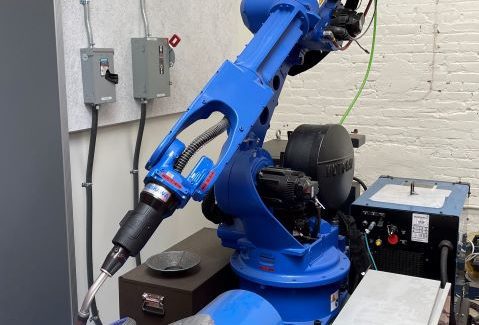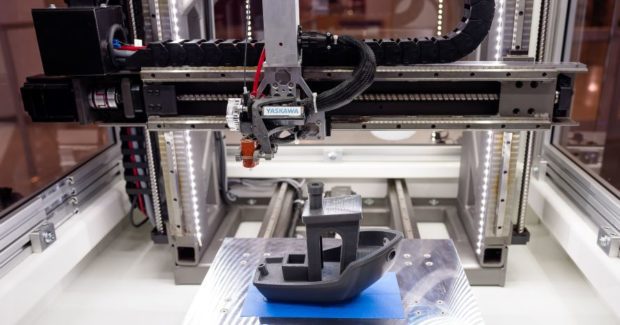Forward in 3D: Rise Above Challenges in 3D Metal Printing
Servo motors and robots are transforming additive applications. Learn the latest tips and applications when implementing robotic automation and advanced motion control for additive and subtractive manufacturing, as well as what’s next: think hybrid additive/subtractive methods.
Posted: July 20, 2021
ADVANCING AUTOMATION
By Sarah Mellish and RoseMary Burns
The adoption of power conversion devices, motion control technology, extremely flexible robots and an eclectic mix of other advanced technologies are driving factors for the rapid growth of new fabricating processes across the industrial landscape. Revolutionizing the way prototypes, parts and products are made, additive and subtractive manufacturing are two prime examples that have provided the efficiency and cost savings fabricators seek to stay competitive.
Referred to as 3D printing, additive manufacturing (AM) is a non-traditional method that usually utilizes digital design data to create solid three-dimensional objects by fusing materials layer by layer from the bottom up. Often making near-net-shape (NNS) parts with no waste, the use of AM for both basic and complex product designs continues to permeate industries like automotive, aerospace, energy, medical, transportation and consumer products. On the contrary, the subtractive process entails removing sections from a block of material by high precision cutting or machining to create a 3D product.
Despite key differences, the additive and subtractive processes are not always mutually exclusive — as they can be used to compliment various stages of product development. An early concept model or prototype is frequently created by the additive process. Once that product is finalized, larger batches may be required, opening the door to subtractive manufacturing. More recently, where time is of the essence, hybrid additive/subtractive methods are being applied for things like repairing damaged/worn parts or creating quality parts with less lead time.
AUTOMATE FORWARD
To meet stringent customer demands, fabricators are integrating a range of wire materials like stainless steel, nickel, cobalt, chrome, titanium, aluminum and other dissimilar metals into their part construction, starting with a soft yet strong substrate and finishing with a hard, wear-resistant component. In part, this has revealed the need for high performance solutions for greater productivity and quality in both additive and subtractive manufacturing environments, especially where processes like wire arc additive manufacturing (WAAM), WAAM-subtractive, laser cladding-subtractive or decoration are concerned. Highlights include:
- Advanced Servo Technology: To better address time-to-market goals and customer design specifications, where dimensional precision and finish quality are concerned, end users are turning to advanced 3D printers with servo systems (over stepper motors) for optimal motion control. The benefits of servo motors, such as Yaskawa’s Sigma-7, turn the additive process on its head, helping fabricators overcomes common issues via printer-boosting capabilities:
- Vibration suppression: robust servo motors boast vibration suppression filters, as well as anti-resonance and notch filters, yielding extremely smooth motion that can eliminate the visually unpleasant stepped lines caused by stepper motor torque ripple.
- Speed enhancement: a print speed of 350 mm/sec is now a reality, more than doubling the average print speed of a 3D printer using a stepper motor. Similarly, a travel speed of up to 1,500 mm/sec can be achieved using rotary or up to 5 meters/sec using linear servo technology. The extremely fast acceleration capability provided through high-performance servos enables 3D print heads to be moved into their proper positions more rapidly. This goes a long way to alleviating the need to slow an entire system down to reach the desired finish quality. Subsequently, this upgrade in motion control also means end users can fabricate more parts per hour without sacrificing quality.
- Automatic tuning: servo systems can independently perform their own custom tuning, which makes it possible to adapt to changes in the mechanics of a printer or variances in a printing process. 3D stepper motors do not utilize position feedback, making it nearly impossible to compensate for changes in processes or discrepancies in mechanics.
- Encoder feedback: robust servo systems that offer absolute encoder feedback only need to perform a homing routine once, resulting in greater uptime and cost savings. 3D printers that use stepper motor technology lack this feature and need to be homed every time they are powered up.
- Feedback sensing: an extruder of a 3D printer can often be a bottleneck in the printing process, and a stepper motor does not have the feedback sensing ability to detect an extruder jam — a deficit that can lead to the ruin of an entire print job. With this in mind, servo systems can detect extruder backups and prevent filament stripping. The key to superior printing performance is having a closed-loop system centered around a high-resolution optical encoder. Servo motors with a 24-bit absolute high-resolution encoder can provide 16,777,216 bits of closed-loop feedback resolution for greater axis and extruder accuracy, as well as synchronization and jam protection.
- High Performance Robots: Just as robust servo motors are transforming additive applications, so too are robots. Their excellent path performance, rigid mechanical structure and high dust protection (IP) ratings — combined with advanced anti-vibration control and multi-axis capability — make highly flexible six-axis robots an ideal option for the demanding processes that surround the utilization of 3D printers, as well as key actions for the subtractive manufacturing and hybrid additive/subtractive methods.
Robotic automation complimentary to 3D printing machines widely entails the handling of printed parts in multi-machine installations. From unloading individual parts from the print machine, to separating parts after a multi-part print cycle, highly flexible and efficient robots optimize operations for greater throughput and productivity gains.
With traditional 3D printing, robots are helpful with powder management, refilling printer powder when needed and removing powder from finished parts. Similarly, other part finishing tasks popular with metal fabrication like grinding, polishing, deburring or cutting are easily achieved. Quality inspection, as well as packaging and logistics needs are also being met head-on with robotic technology, freeing fabricators to focus their time on higher value-added work, like custom fabrication.
For larger workpieces, long-reach industrial robots are being tooled to directly move a 3D printer extrusion head. This, in conjunction with peripheral tools like rotating bases, positioners, linear tracks, gantries and more, are providing the workspace required to create spatial free-form structures. Apart from classical rapid prototyping, robots are being used for the fabrication of large volume free-form parts, mold forms, 3D-shaped truss constructions and large-format hybrid parts. - Multi-axis Machine Controllers: Innovative technology for connecting up to 62 axes of motion in a single environment is now making multi-synchronization of a broad range of industrial robots, servo systems and variable frequency drives used in the additive, subtractive and hybrid processes possible. An entire family of devices can now work seamlessly together under the complete control and monitoring of a PLC (Programmable Logic Controller) or IEC machine controller, such as the MP3300iec. Often programmed with a dynamic 61131 IEC software package, such as MotionWorks IEC, professional platforms like this utilize familiar tools (i.e., RepRap G-codes, Function Block Diagram, Structured Text, Ladder Diagram, etc.). To facilitate easy integration and optimize machine uptime, ready-made tools like bed leveling compensation, extruder pressure advance control, multiple spindle and extruder control are included.
- Advanced Manufacturing User Interfaces: Highly beneficial to applications in 3D printing, shape cutting, machine tool and robotics, diverse software packages can quickly deliver an easy-to-customize graphical machine interface, providing a pathway to greater versatility. Designed with creativity and optimization in mind, intuitive platforms, like Yaskawa Compass, allow manufacturers to brand and easily customize screens. From including core machine attributes to accommodating customer needs, little programming is required — as these tools provide an extensive library of prebuilt C# plug-ins or enable the importing of custom plug-ins.
RISE ABOVE
While the single additive and subtractive processes remain popular, a greater shift toward the hybrid additive/subtractive method will occur during the next few years. Expected to grow at a compound annual growth rate (CAGR) of 14.8 percent by 20271, the hybrid additive manufacturing machine market is poised to meet the uptick in evolving customer demands. To rise above the competition, manufacturers should weigh the pros and cons of the hybrid method for their operations. With the ability to produce parts as needed, to a major reduction in carbon footprint, the hybrid additive/subtractive process offers some attractive benefits. Regardless, the advanced technologies for these processes should not be overlooked and should be implemented on shop floors to facilitate greater productivity and product quality.
Reference
1 Hybrid Additive Manufacturing Market Size, Share & Trends, Grand View Research, 2020






